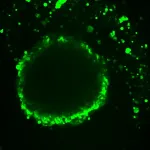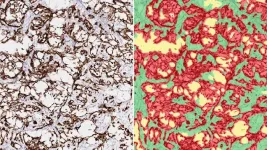(Press-News.org) A team of researchers at Baylor College of Medicine is gaining ground in their search for solutions to the global problem of bacterial antibiotic resistance, which was responsible for nearly 1.3 million deaths in 2019.
The team reports in the journal Science Advances a drug that, in laboratory cultures and animal models, significantly reduces the ability of bacteria to develop antibiotic resistance, which might prolong antibiotic effectiveness. The drug, called dequalinium chloride (DEQ), is a proof-of-concept for evolution-slowing drugs.
“Most people with bacterial infections get better after completing antibiotic treatment, but there are also many cases in which people decline because the bacteria develop resistance to the antibiotic, which then can no longer kill the bacteria,” said corresponding author Dr. Susan M. Rosenberg, Ben F. Love Chair in Cancer Research and professor of molecular and human genetics, biochemistry and molecular biology and molecular virology and microbiology at Baylor. She also is a program leader in Baylor’s Dan L Duncan Comprehensive Cancer Center (DLDCCC).
In this study, Rosenberg and her colleagues looked for drugs that could prevent or slow down E. coli bacteria from developing resistance to two antibiotics when exposed to a third antibiotic, ciprofloxacin (cipro), the second most prescribed antibiotic in the U.S. and one associated with high bacterial resistance rates.
The resistance is caused by new gene mutations that occur in the bacteria during infection. The drug DEQ reduces the speed at which new mutations are formed in bacteria, the team finds.
Previous work from the Rosenberg lab had shown that bacterial cultures in the lab exposed to cipro turn up mutation rate. They found a mutational “program” that is switched on by bacterial stress responses. Stress responses are genetic programs that instruct cells to increase production of protective molecules during stress, including stress from low concentrations of cipro. Low concentrations occur at the beginning and end of antibiotic therapies and if doses are missed.
The same stress responses also increase the ability to make genetic mutations, the Rosenberg group, then many other labs, have shown. Some of the mutations can confer resistance to cipro, while other mutations can allow resistance to antibiotics not yet encountered. Mutation-generating processes that are turned on by stress responses are called stress-induced mutation mechanisms.
Bacteria with antibiotic resistance mutations can then sustain an infection in the presence of cipro. This study is the first to show that in animal infections treated with cipro, the bacteria activate a known stress-induced genetic mutational process. Cipro resistance occurs mostly by the bacteria developing new mutations, both clinically and in the laboratory, rather than by acquiring genes that confer antibiotic resistance from other bacteria.
Looking to prevent the development of antibiotic resistance, the researchers screened 1,120 drugs approved for human use for their ability to dial down the master bacterial stress response, which they showed counters the emergence of resistance mutations. In addition, and counterintuitively, they wanted “stealth” drugs that would not slow bacterial proliferation, which would confer a growth advantage to any bacterial mutants that resist the mutation-slowing drug itself. That is, drugs that are not antibiotics themselves.
“We found that DEQ fulfilled both requirements. Given together with cipro, DEQ reduced the development of mutations that confer antibiotic resistance, both in laboratory cultures and in animal models of infection, and bacteria did not develop resistance to DEQ,” said first author Yin Zhai, a postdoctoral associate in the Rosenberg lab. “In addition, we achieved this mutation-slowing effect at low DEQ concentrations, which is promising for patients. Future clinical trials are needed to evaluate the ability of DEQ to decelerate bacterial antibiotic resistance in patients.”
Other contributors to this work include John P. Pribis, Sean W. Dooling, Libertad Garcia-Villada, P.J. Minnick, Jun Xia, Jingjing Liu, Qian Mei, Devon M. Fitzgerald, Christophe Herman, P.J. Hastings and Mauro Costa-Mattioli. The authors are affiliated with one or more of the following institutions: Baylor College of Medicine, the Dan L Duncan Comprehensive Cancer Center and Rice University.
This work was supported by NIH Directors Pioneer Awards DP1-AI52073 and DP1-AG072751, and NIH grants R35-GM122598 and R01-CA250905, P30-AI036211, P30-CA125123 and S10-RR024574, the Dan L Duncan Comprehensive Cancer Center and the John S. Dunn Gulf Coast Consortium for Chemical Genomics. Further support was provided by the State of Nebraska LB595 and LB692 and NIH/NIEHS R00ES033259 awards.
###
END
Drug decelerates bacterial race to antibiotic resistance
2023-06-23
ELSE PRESS RELEASES FROM THIS DATE:
New excess mortality estimates show increases in US rural mortality during second year of COVID-19 pandemic
2023-06-23
Between the first and second year of the COVID-19 pandemic, excess deaths decreased in large metropolitan counties and increased in rural counties in the United States, according to a new study led by Boston University School of Public Health (BUSPH) and The University of Pennsylvania (UPenn).
The novel study presents the first-ever monthly estimates of excess mortality rates for every US county during the first two years of the pandemic.
Excess mortality, which compares observed deaths to the number of deaths that would be expected ...
New excess mortality estimates show increases in US rural deaths during second year of COVID-19 pandemic
2023-06-23
Between the first and second year of the COVID-19 pandemic, excess deaths decreased in large metropolitan counties and increased in rural counties in the United States, according to a new study led by Boston University School of Public Health (BUSPH) and The University of Pennsylvania (UPenn).
The novel study presents the first-ever monthly estimates of excess mortality rates for every US county during the first two years of the pandemic.
Excess mortality, which compares observed deaths to the number of deaths that would be expected under normal conditions in a given ...
FSU assistant professor’s research helps determine origins of plate tectonics
2023-06-23
A Florida State University faculty member’s research is helping to uncover more about the conditions necessary for the beginnings of life on Earth.
FSU Assistant Professor Richard Bono was part of a multi-institution team that found evidence that the planet’s magnetic field was stable from 3.9 to 3.4 billion years ago, a time when scientists think life may have first originated. Their research was published in Nature.
Bono explained more about what the team found and its implications for the origins of plate tectonics and life on Earth.
What did the research team find?
Our research showed ...
The force of blows to the head, not just how many, raises likelihood of CTE
2023-06-23
For years, researchers studying chronic traumatic encephalopathy, or CTE, believed the primary cause of it was repetitive hits to the head, whether or not those hits caused concussions. They believed the more frequently that a person sustained head blows, the more likely they were to develop neurological and cognitive struggles later in life.
A new collaborative study conducted by researchers at Boston University, Mass General Brigham, and Harvard Medical School—using brains donated to BU’s ...
UTIA instrumental in launch of Southern Ag Today
2023-06-23
Extension economists from 13 land-grant universities have joined forces to launch Southern Ag Today, a new digital platform featuring daily news, articles and resources related to issues affecting agriculture in the South.
Agricultural producers and policymakers will find the latest information on topics including crop and livestock marketing, farm management, agricultural policy, trade, agricultural law and specialty topics, making it the only collection of its kind focused on agriculture in the Southern region.
Crop marketing specialist Aaron Smith and agricultural trade expert Andrew Muhammad from the Department of Agricultural and Resource Economics at the University of ...
Researchers show how a tumor cell’s location and environment affect its identity
2023-06-23
Using 3-D models of ovarian cancer tumors, scientists found differences in gene activity based on where a cell is in a tumor, demonstrating how a cell’s location and environment in a cancerous tumor can strongly influence which genes are active and the cell’s role in the cancer’s biology. More specifically, the team co-led by researchers at the National Center for Advancing Translational Sciences (NCATS), part of the National Institutes of Health, showed that gene activity in cells at or near a tumor’s surface differed from that of cells closer to the tumor center.
The approach pairs the use of a technology to reveal the genetic activity of single ...
Nuclear medicine global initiative reports worldwide challenges and opportunities in theranostics education
2023-06-23
Reston, VA—Leaders from 12 nuclear medicine organizations around the world have issued a white paper about the challenges and opportunities in theranostics education. Published in the June issue of The Journal of Nuclear Medicine, the report outlines the current theranostic educational and accreditation offerings across the globe. It also provides guidelines to assist countries in developing educational and training curriculums that enable physicians to confidently and safely perform nuclear ...
$20 million awarded for scientific research to address health challenges in rural areas
2023-06-23
DALLAS, June 23, 2023 — People who live in rural areas of the U.S. are 40% more likely to develop heart disease and have a 30% higher risk of stroke than people who live in urban areas, according to data reported in the 2020 Call to Action: Rural Health: A Presidential Advisory From the American Heart Association and American Stroke Association. At least 20% of the U.S. population live in rural areas and these people face unique health challenges related to individual risk factors, social determinants of health and lack of access to health care. To address this issue, the American Heart Association, the world's leading nonprofit organization focused on ...
How popular steroids could mess up some cancer treatments
2023-06-23
Immunotherapy is among the newest and most potent weapons against cancer. It prompts the immune system to recognize tumors as intruders in the body and attack. But not all patients respond well to immunotherapy. Why? Scientists aren’t always sure.
Sometimes, immunotherapy patients experience side effects that steroids called glucocorticoids (GCs) can treat. GCs are often used to regulate the immune response in conditions such as asthma, Crohn’s disease, and even COVID-19. Yet just how they work is also a mystery.
Now, Cold Spring Harbor Laboratory (CSHL) researchers may be closer to answering both questions. Their new research indicates GCs may indirectly lead ...
Treatment for opioid use disorder varies widely among states, study finds
2023-06-23
Despite a national opioid overdose epidemic supercharged by a surge of illicit fentanyl, new research from Oregon Health & Science University reveals wide discrepancies among U.S. states in effectively treating opioid use disorder among people covered by Medicaid.
The study, published today in the journal JAMA Health Forum, found that in many states, fewer than half of people diagnosed with opioid use disorder received proven medications to treat it.
“We fail people by not providing adequate treatment to people with opioid use disorder enrolled in Medicaid,” said lead author Stephan Lindner, Ph.D., associate professor in ...




